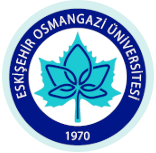MEMBERSHIP/BORROWING PROCESSES
a) Our university students and staff are natural members of our library. However, they must be registered to use the library services.
b) Users can register by applying to our library, or they can click on the member login section on our library page and register themselves from the sign up section in the Eskişehir Osmangazi University Library submenu in the upper left corner.
c) Our users are required to present their university ID cards each time they enter the library and borrow books. No other person's ID cards can be used to take action.
d) The number of books that can be borrowed, return and extension periods are as follows;
|
User |
Number of Books that can be Borrowed |
Return Period |
Extension Period |
|
Academic staff |
12 books |
30 days |
3 times |
|
Administrative staff |
7 books |
30 days |
2 times |
|
Doctorate students |
12 books |
30 days |
2 times |
|
Postgraduate students |
12 books |
30 days |
2 times |
|
Graduate / Associate degree students |
7 books |
15 days |
2 times |
e) Our users can extend the usage period of their information resources, if there is no reservation on the work, by using their own library login.
f) You can also place a reservation for resources that are available in our library but not on the reader. Our users can do this themselves by opening their personal library sessions. To do this, they must first find the book they want to reserve by clicking on the catalogue search while logged in. Then, all they have to do is click on the book button here. The person cannot extend the reserved work and must return it at the end of the period. For the returned item, an e-mail will be sent to the person who placed the reservation at the same time, informing them that the reserved item has arrived at the library. The person must collect this book from the Borrowing Service within 3 days. Works not collected within 3 days will be put back on the shelf.
g) Unbound journals, reference books, master's and doctoral theses, rare works, atlases and maps, audiovisual materials, musical scores, collection pieces, artistic materials, and reserved works may be loaned for a limited period if deemed appropriate by the management.
h) Our library users can also carry out their borrowing, returning and extending transactions themselves at our self-checkout device, which is a borrowing station. For transactions other than refunds, it will be sufficient for them to scan their institutional ID cards and enter their passwords. The passwords here are the same as the passwords in the Login menu that they use to access the Library remotely. For the return process, an ID card is not required; scanning the barcode on the back cover of the book will be sufficient.
i) For your transaction security, it is recommended that you obtain a receipt for transactions made using the self-check device.
j) Our users who have an overdue information source cannot borrow a new information source or extend the period without returning the information source.
k) The number of books that can be borrowed, the loan periods and the number of extensions can be rearranged by the library management if necessary.
l) Our readers who have expired resources must return the work at the end of the period. They cannot get new books without returning this resource, and they cannot use library services for 3 days for each day they are late.
m) For lost/damaged materials, the person must purchase an exact copy of the lost or damaged material and return it to the library. Users who do not complete this process and who have materials on them cannot be dismissed from the institution.
FINDING THE SEARCHED MATERIALS-SCANNING THE LIBRARY CATALOGUE
To find the desired resource in the library collection, you can search using criteria such as author, book title, subject, series name, call number, etc., using the catalog search link on the library website, or you can use the search terminals located on the library floors.
a) It is recommended that our users who wish to conduct extensive research use appropriate keywords and keep the search criteria set to all.
b) First of all, it is necessary to check whether the resource found as a result of the scan is on the shelf or not on the scan page. Then, the source should be scanned in the appropriate hall by checking which hall it belongs to.
c) Since our library uses the LC Classification System, a classification record consisting of letters and numbers indicating the subject of the relevant source will be displayed. This record should be taken and the relevant source should be found from the hall.
d) For resources that are not available on-site, please consult the library staff on the floors.
Lending Contact : 0 222 239 37 50 / 1714

